Soil-Mediated Effects on Weed-Crop Competition: Elucidating the Role of Annual and Perennial Intercrop Diversity Legacies
Abstract
1. Introduction
2. Materials and Methods
2.1. Soil Conditioning Treatments
2.2. Conditioning Phase Crop Sampling
2.3. Soil Sampling and Testing
2.4. Greenhouse Experiment
2.5. Statistical Analysis
3. Results and Discussion
3.1. Conditioning Phase Soil Characteristics and Crop Biomass
| SOM | Bulk Density | pH | Aggregate Stability | Gravimetric Moisture | Respiration | P | K | Mg | Ca | BG | NAG | |
|---|---|---|---|---|---|---|---|---|---|---|---|---|
| Effect | p-value | |||||||||||
| Diversity (D) | 0.74 | 0.08 | 0.45 | 0.40 | 0.52 | 0.92 | 0.32 | 0.40 | 0.63 | 0.76 | 0.33 | 0.30 |
| System (S) | 0.96 | 0.001 | 0.0002 | 0.40 | 0.01 | 0.45 | >0.0001 | >0.0001 | 0.30 | 0.04 | 0.95 | 0.72 |
| D × S | 0.94 | 0.50 | 0.47 | 0.52 | 0.91 | 0.96 | 0.26 | 0.16 | 0.70 | 0.38 | 0.23 | 0.24 |
| System | (%) | (g/cm3) | (%) | (%) | (mgC/g) | (ppm) | (ppm) | (ppm) | (ppm) | (nmol/h/g) | (nmol/h/g) | |
| Annual | 3.81 | 1.32 | 7.92 | 27 | 0.20 | 0.75 | 7.04 | 43 | 322 | 3058 | 86 | 17 |
| Perennial | 3.80 | 1.33 | 7.85 | 29 | 0.19 | 0.73 | 5.06 | 61 | 309 | 2777 | 87 | 18 |
3.2. Crop Diversity Legacy Effects on Weed-Crop Competition
4. Conclusions
Supplementary Materials
Author Contributions
Funding
Acknowledgments
Conflicts of Interest
References
- Renton, M.; Chauhan, B.S. Modelling crop-weed competition: Why, what, how and what lies ahead? Crop Prot. 2017, 95, 101–108. [Google Scholar] [CrossRef]
- Pimentel, D.; McNair, S.; Janecka, J.; Wightman, J.; Simmonds, C.; O’Connell, C.; Wong, E.; Russel, L.; Zern, J.; Aquino, T.; et al. Economic and environmental threats of alien plant, animal, and microbe invasions. Agric. Ecosyst. Environ. 2001, 84, 1–20. [Google Scholar] [CrossRef]
- Garcia-Torres, L.; Benites, J.; Martinez-Viela, A.; Holgado-Cabrera, A. Conservation Agriculture Environment, Farmers Experiences, Innovations, Socio-Economy, Policy; Springer: Dordrecht, The Netherlands, 2003; ISBN 9781402011061. [Google Scholar]
- Kirkegaard, J.A.; Conyers, M.K.; Hunt, J.R.; Kirkby, C.A.; Watt, M.; Rebetzke, G.J. Sense and nonsense in conservation agriculture: Principles, pragmatism and productivity in Australian mixed farming systems. Agric. Ecosyst. Environ. 2014, 187, 133–145. [Google Scholar] [CrossRef]
- Lahmar, R. Adoption of conservation agriculture in Europe: Lessons of the KASSA project. Land Use Policy 2010, 27, 4–10. [Google Scholar] [CrossRef]
- Heap, I. Herbicide Resistant Weeds. In Integrated Pest Management: Pesticide Problems Volume 3; Pimentel, D., Peshin, R., Eds.; Springer: Dordrecht, The Netherlands, 2014; pp. 281–301. [Google Scholar]
- Bastiaans, L.; Paolini, R.; Baumann, D.T. Focus on ecological weed management: What is hindering adoption? Weed Res. 2008, 48, 481–491. [Google Scholar] [CrossRef]
- Médiène, S.; Valantin-Morison, M.; Sarthou, J.-P.; de Tourdonnet, S.; Gosme, M.; Bertrand, M.; Roger-Estrade, J.; Aubertot, J.-N.; Rusch, A.; Motisi, N.; et al. Agroecosystem management and biotic interactions: A review. Agron. Sustain. Dev. 2011, 31, 491–514. [Google Scholar] [CrossRef]
- Gaba, S.; Lescourret, F.; Boudsocq, S.; Enjalbert, J.; Hinsinger, P.; Journet, E.-P.; Navas, M.-L.; Wery, J.; Louarn, G.; Malézieux, E.; et al. Multiple cropping systems as drivers for providing multiple ecosystem services: From concepts to design. Agron. Sustain. Dev. 2015, 35, 607–623. [Google Scholar] [CrossRef]
- Smith, R.G.; Mortensen, D.A.; Ryan, M.R. A new hypothesis for the functional role of diversity in mediating resource pools and weed-crop competition in agroecosystems. Weed Res. 2010, 50, 37–48. [Google Scholar] [CrossRef]
- Ryan, M.R.; Mortensen, D.A.; Bastiaans, L.; Teasdale, J.R.; Mirsky, S.B.; Curran, W.S.; Seidel, R.; Wilson, D.O.; Hepperly, P.R. Elucidating the apparent maize tolerance to weed competition in long-term organically managed systems. Weed Res. 2010, 50, 25–36. [Google Scholar] [CrossRef]
- Reynolds, H.L.; Packer, A.; Bever, J.D.; Clay, K. Grassroots ecology: Plant-microbe-soil interactions as drivers of plant community structure and dynamics. Ecology 2003, 84, 2281–2291. [Google Scholar] [CrossRef]
- Klironomos, J.N. Feedback with soil biota contributes to plant rarity and invasiveness in communities. Nature 2002, 417, 67–70. [Google Scholar] [CrossRef] [PubMed]
- Bever, J.D. Feedback between plants and their soil communities in an old field community. Ecology 1994, 75, 1965–1977. [Google Scholar] [CrossRef]
- Bever, J.D.; Westover, K.M.; Antonovics, J. Incorporating the soil community into plant population dynamics: The utility of the feedback approach. J. Ecol. 1997, 85, 561–573. [Google Scholar] [CrossRef]
- Ehrenfeld, J.G.; Ravit, B.; Elgersma, K. Feedback in the plant-soil system. Annu. Rev. Environ. Resour. 2005, 30, 75–115. [Google Scholar] [CrossRef]
- Johnson, N.C.; Pfleger, F.L.; Crookston, R.K.; Simmons, S.R.; Copeland, P.J. Vesicular-arbuscular mycorrhizas respond to corn and soybean cropping history. New Phytol. 1991, 117, 657–663. [Google Scholar] [CrossRef]
- Miller, Z.J.; Menalled, F.D. Impact of species identity and phylogenetic relatedness on biologically-mediated plant-soil feedbacks in a low and a high intensity agroecosystem. Plant Soil 2015, 389, 171–183. [Google Scholar] [CrossRef]
- Brinkman, P.; Van der Putten, W.H.; Bakker, E.-J.; Verhoeven, K.J.F. Plant–soil feedback: Experimental approaches, statistical analyses and ecological interpretations. J. Ecol. 2010, 98, 1063–1073. [Google Scholar] [CrossRef]
- van der Putten, W.H.; Bradford, M.A.; Pernilla Brinkman, E.; van de Voorde, T.F.J.; Veen, G.F. Where, when and how plant–soil feedback matters in a changing world. Funct. Ecol. 2016, 30, 1109–1121. [Google Scholar] [CrossRef]
- Johnson, S.P.; Miller, Z.J.; Lehnhoff, E.A.; Miller, P.R.; Menalled, F.D. Cropping systems modify soil biota effects on wheat (Triticum aestivum) growth and competitive ability. Weed Res. 2017, 57, 6–15. [Google Scholar] [CrossRef]
- Menalled, U.D.; Seipel, T.; Menalled, F.D. Farming system effects on biologically mediated plant–soil feedbacks. Renew. Agric. Food Syst. 2020, 1–7. [Google Scholar] [CrossRef]
- Northeast Regional Climate Center, Climod2: Monthly Summarized Data. Available online: http://climod2.nrcc.cornell.edu (accessed on 20 May 2020).
- Bybee-Finley, K.; Ryan, M. Advancing intercropping research and practices in industrialized agricultural landscapes. Agriculture 2018, 8, 80. [Google Scholar] [CrossRef]
- Ketterings, Q.; Ort, S.; Swink, S.; Godwin, G.; Kilcer, T.; Miller, J.; Verbeten, W. Winter cereals as double crops in corn rotations on New York dairy farms. J. Agric. Sci. 2015, 7, 18–25. [Google Scholar] [CrossRef]
- Darby, H.M.; Madden, R.; Cummings, E.; Gervais, A.; Halteman, P. 2010 Warm Season Annual Forage Performance Trials; University of Vermont: Burlington, VT, USA, 2011. [Google Scholar]
- Undersander, D.; Cosgrove, D.; Cullen, E.; Grau, C.; Rice, M.E.; Renz, M.; Sheaffer, C.; Shewmaker, G.; Sulc, M. Alfalfa Management Guide; Amer Society of Agronomy: Madison, WI, USA, 2011; ISBN 9780891181798. [Google Scholar]
- Saiya-Cork, K.R.; Sinsabaugh, R.L.; Zak, D.R. The effects of long term nitrogen deposition on extracellular enzyme activity in an Acer saccharum forest soil. Soil Biol. Biochem. 2002, 39, 1309–1315. [Google Scholar] [CrossRef]
- Neher, D.A.; Cutler, A.J.; Weicht, T.R.; Sharma, M.; Millner, P.D. Composts of poultry litter or dairy manure differentially affect survival of enteric bacteria in fields with spinach. J. Appl. Microbiol. 2019, 126, 1910–1922. [Google Scholar] [CrossRef]
- Moebius-Clune, B.; Moebius-Clune, D.J.; Gugino, B.K.; Idowu, O.J.; Schindelbeck, R.; Ristow, A.J.; van Es, H.; Thies, J.E.; Shayler, H.A.; McBride, M.B.; et al. Comprehensive Assessment of Soil Health: The Cornell Framework, 3.2 ed.; Cornell University: Geneva, NY, USA, 2017; ISBN 0967650763. [Google Scholar]
- Hol, W.H.G.; de Boer, W.; ten Hooven, F.; van der Putten, W.H. Competition increases sensitivity of wheat (Triticum aestivum) to biotic plant-soil feedback. PLoS ONE 2013, 8, e66085. [Google Scholar] [CrossRef]
- Uva, R.H.; Neal, J.C.; DiTomaso, J.M. Weeds of the Northeast; Comstock Pub.: Ithaca, NY, USA, 1997; ISBN 0801433916. [Google Scholar]
- Sarabi, V.; Nassiri-Mahallati, M.; Nezami, A.; Rashed Mohassel, M.H. Effects of common lambsquarters (Chenopodium album L.) emergence time and density on growth and competition of maize (Zea mays L.). Aust. J. Crop Sci. 2013, 7, 532–537. [Google Scholar]
- Tester, M.; Smith, S.; Smith, F. The phenomenon of “nonmycorrhizal” plants. Can. J. Bot. 2011, 65, 419–431. [Google Scholar] [CrossRef]
- Vatovec, C.; Jordan, N.; Huerd, S. Responsiveness of certain agronomic weed species to arbuscular mycorrhizal fungi. Renew. Agric. Food Syst. 2005, 20, 181–189. [Google Scholar] [CrossRef]
- Chen, J.; Bird, G.W.; Renner, K.A. Influence of Heterodera glycines on interspecific and intraspecific competition associated with glycine max and chenopodium album. J. Nematol. 1995, 27, 63–69. [Google Scholar]
- R Core Team. R: A Language and Environment for Statistical Computing; R Foundation for Statistical Computing: Vienna, Austria, 2019. [Google Scholar]
- Kuznetsova, A.; Brockhoff, P.B.; Christensen, R.H.B. lmerTest Package: Tests in linear mixed effects models. J. Stat. Softw. 2017, 82, 1–26. [Google Scholar] [CrossRef]
- Lenth, R. Emmeans: Estimated Marginal Means, Aka Least-Squares Means. R Package Version 1.4. Available online: https://cran.r-project.org/web/packages/emmeans/index.html (accessed on 20 May 2020).
- Pinheiro, J.; Bates, D.; DebRoy, S.; Sarkar, D. nlme: Linear and Nonlinear Mixed Effects Models. R package version 3.1-149. Available online: https://cran.r-project.org/web/packages/nlme/index.html (accessed on 11 September 2020).
- Spitters, C.J.T. An alternative approach to the analysis of mixed cropping experiments. 1. Estimation of competition effects. Neth. J. Agric. Sci. 1983, 31, 1–11. [Google Scholar] [CrossRef]
- Bruce, R.R.; Langdale, G.W.; Dillard, A.L. Tillage and crop rotation effect on characteristics of a sandy surface soil. Soil Sci. Soc. Am. J. 1990, 54, 1744–1747. [Google Scholar] [CrossRef]
- Rhoton, F.E.; Bruce, R.R.; Buehring, N.W.; Elkins, G.B.; Langdale, C.W.; Tyler, D.D. Chemical and physical characteristics of four soil types under conventional and no-tillage systems. Soil Tillage Res. 1993, 28, 51–61. [Google Scholar] [CrossRef]
- Khan, A.R. Influence of tillage on soil aeration. J. Agron. Crop Sci. 1996, 177, 253–259. [Google Scholar] [CrossRef]
- Vyn, T.J.; Raimbult, B.A. Long-term effect of five tillage systems on corn response and soil structure. Agron. J. 1993, 85, 1074. [Google Scholar] [CrossRef]
- Haynes, R.J.; Judge, A. Influence of surface-applied poultry manure on topsoil and subsoil acidity and salinity: A leaching column study. J. Plant Nutr. Soil Sci. 2008, 171, 370–377. [Google Scholar] [CrossRef]
- Talbot, J.M.; Treseder, K.K. Interactions among lignin, cellulose, and nitrogen drive litter chemistry–decay relationships. Ecology 2012, 93, 345–354. [Google Scholar] [CrossRef]
- Lawrence, J.; Ketterings, Q.; Cherney, J. Effect of nitrogen application on yield and quality of silage corn after forage legume-grass. Agron. J. 2008, 100, 73–79. [Google Scholar] [CrossRef]
- Singh, K.; Ch, S.; Swarnalakshmi, K.; Ganeshamurthy, A.; Kumar, N. Influence of legume residues management and nitrogen doses on succeeding wheat yield and soil properties in Indo-Gangetic Plains. J. Food Legum. 2012, 25, 116–120. [Google Scholar]
- Garside, A.; Berthelsen, J.E. Management of legume biomass to maximise benefits to the following sugarcane crop. Proc. Aust. Soc. Sugar Cane Technol. 2004, 26, 30–56. [Google Scholar]
- Fernandez, A.L.; Fabrizzi, K.P.; Tautges, N.E.; Lamb, J.A.; Sheaffer, C.C. Cutting management and alfalfa stand age effects on organically grown corn grain yield and soil N availability. Renew. Agric. Food Syst. 2017, 34, 144–154. [Google Scholar] [CrossRef]
- Pugliese, J.Y.; Culman, S.W.; Sprunger, C.D. Harvesting forage of the perennial grain crop kernza (Thinopyrum intermedium) increases root biomass and soil nitrogen cycling. Plant Soil 2019, 437, 241–254. [Google Scholar] [CrossRef]
- Paterson, E.; Sim, A. Rhizodeposition and C-partitioning of Lolium perenne in axenic culture affected by nitrogen supply and defoliation. Plant Soil 1999, 216, 155–164. [Google Scholar] [CrossRef]
- Klumpp, K.; Fontaine, S.; Attard, E.; Le Roux, X.; Gleixner, G.; Soussana, J.-F. Grazing triggers soil carbon loss by altering plant roots and their control on soil microbial community. J. Ecol. 2009, 97, 876–885. [Google Scholar] [CrossRef]
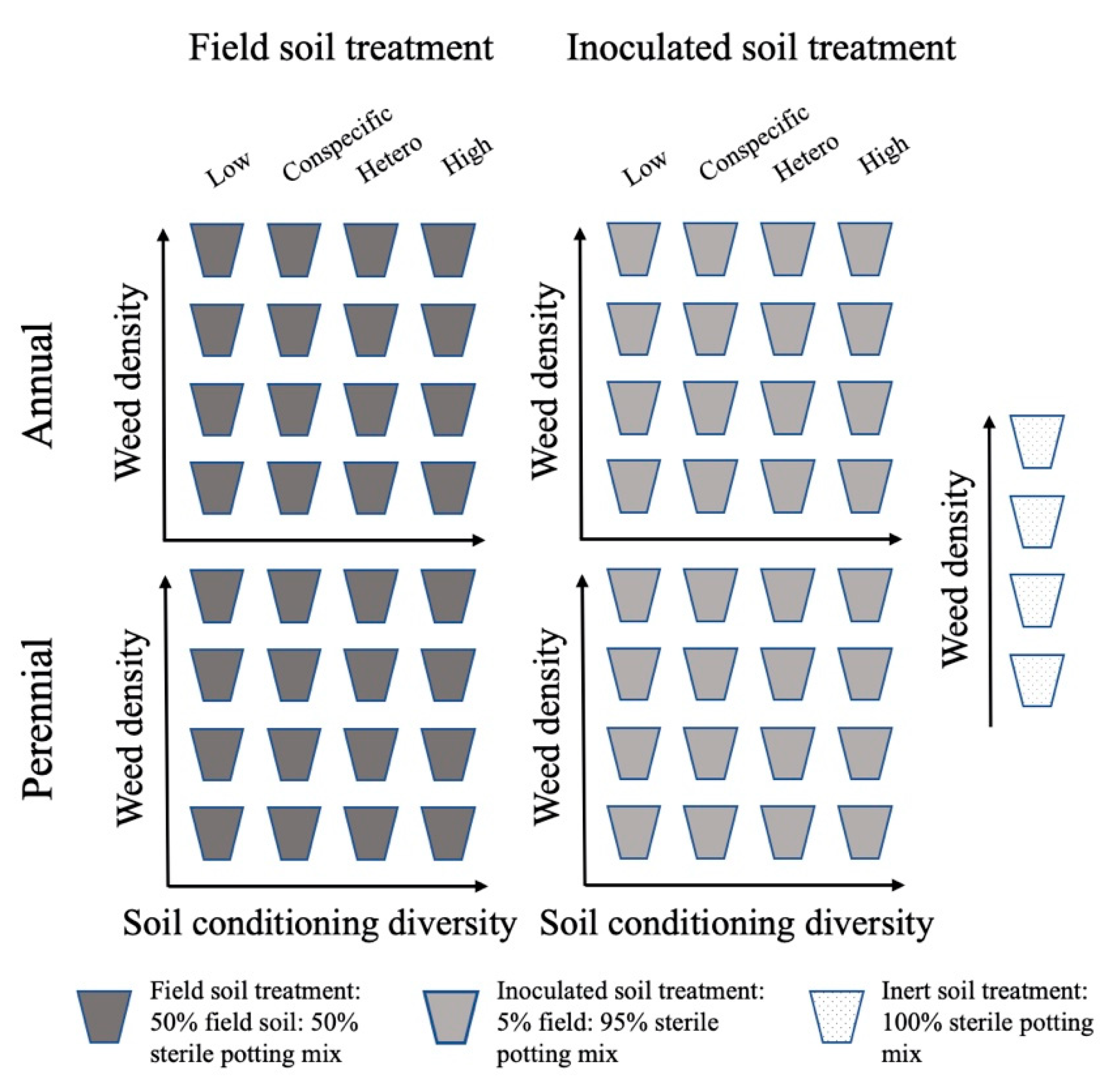
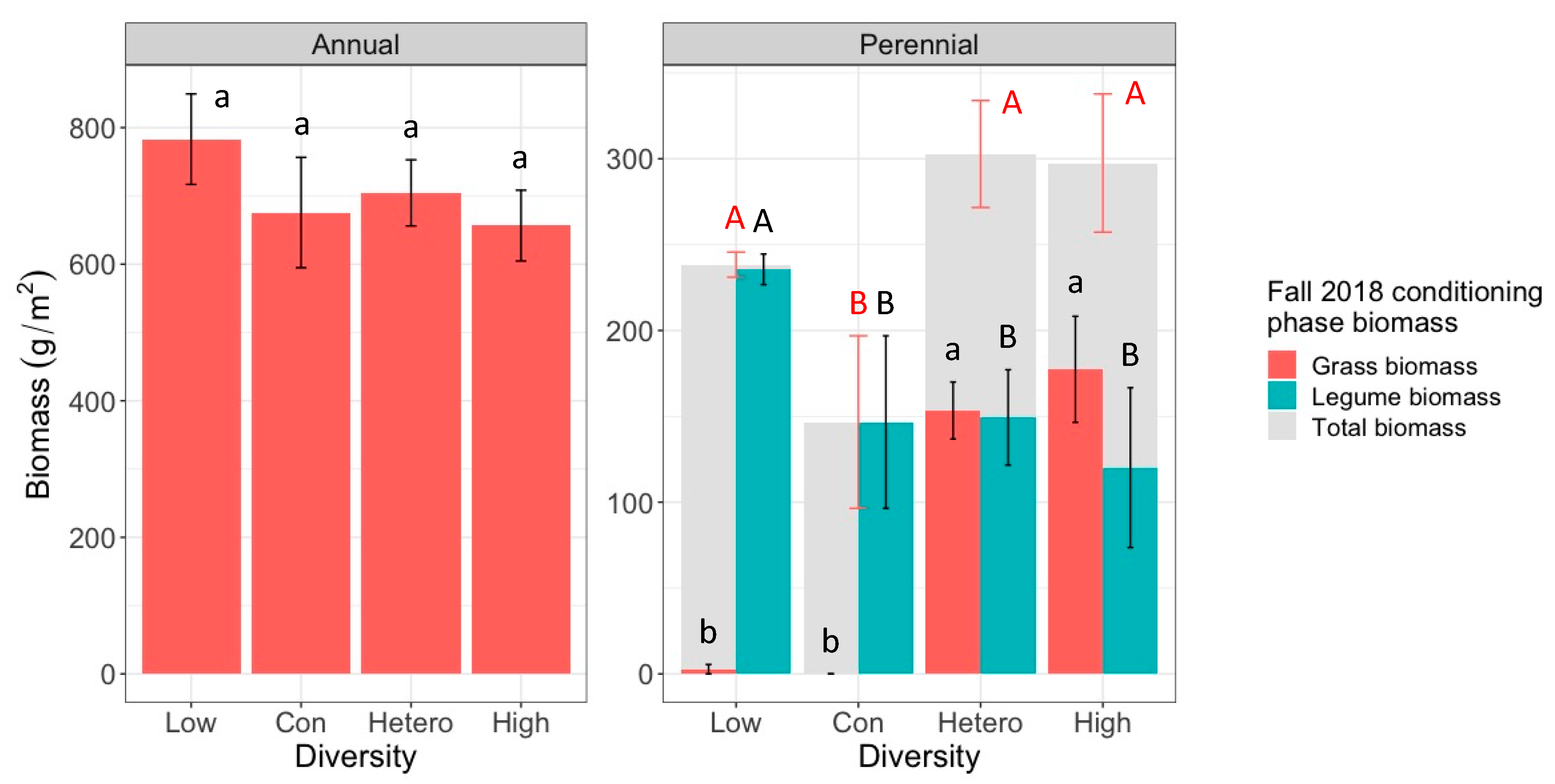
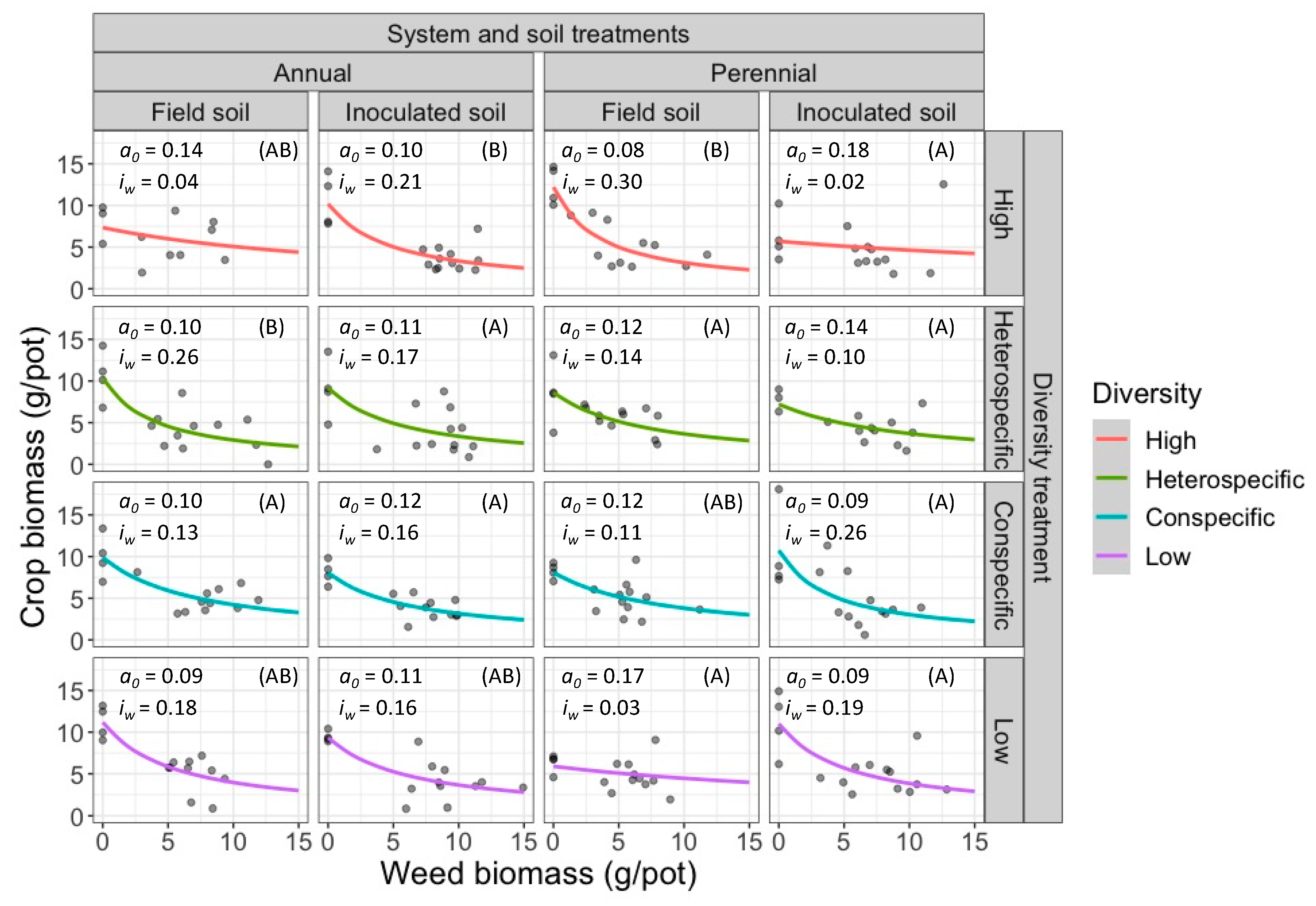
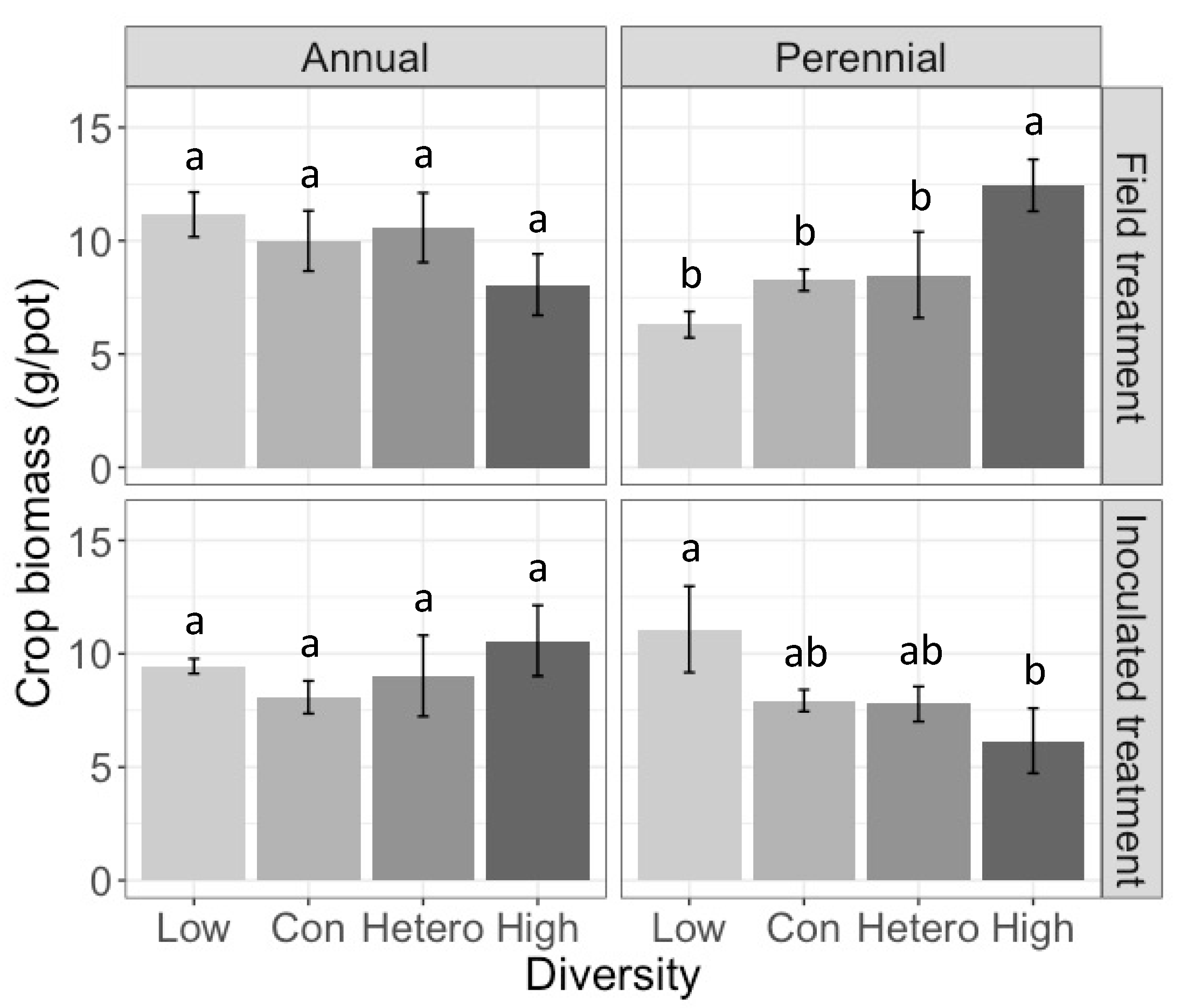
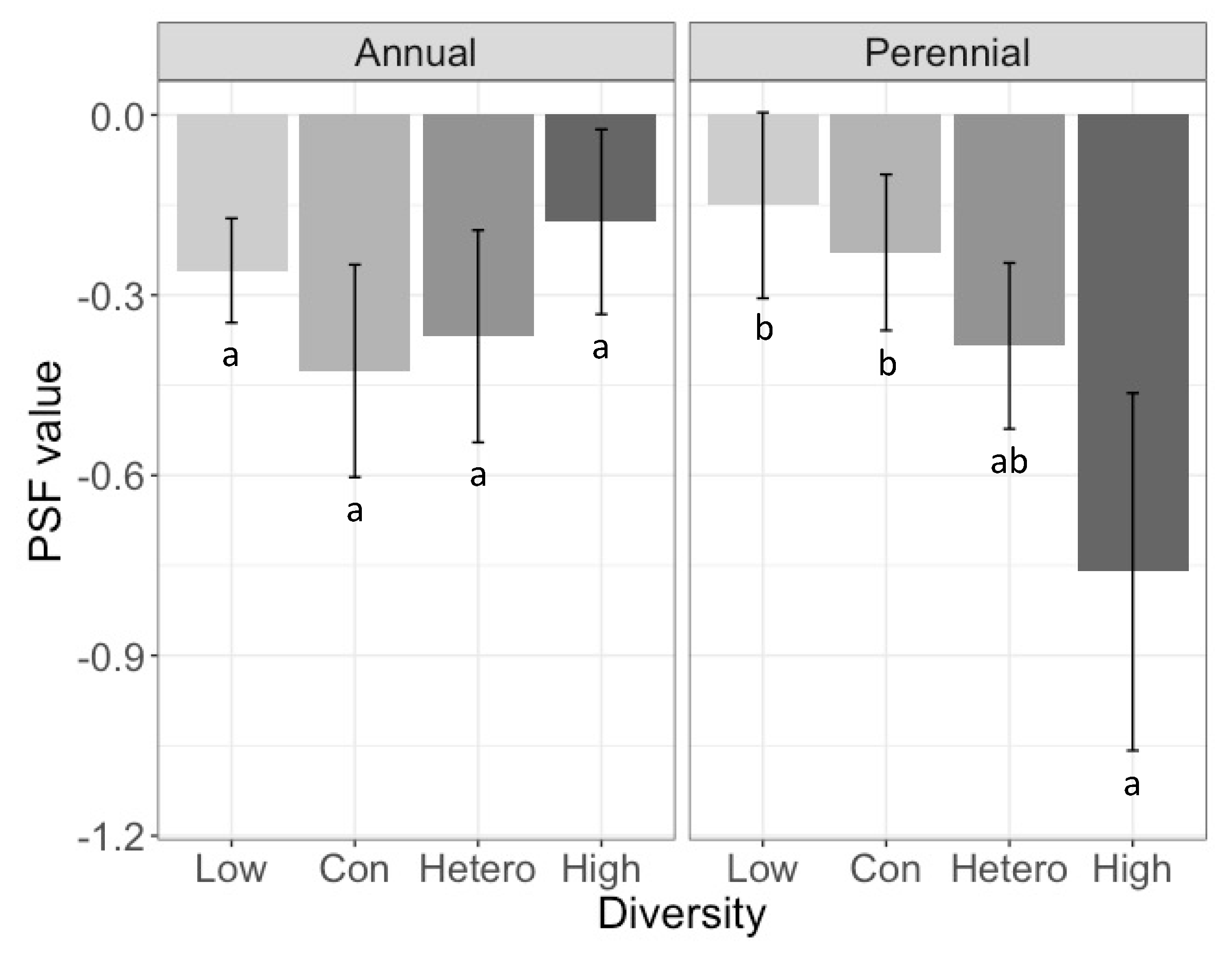
| Diversity Treatments | ||||||
|---|---|---|---|---|---|---|
| Low | Conspecific | Heterospecific | High | |||
| Cropping system treatments | Annuals | Summer annuals | One cultivar of sorghum sudangrass | Four cultivars of sorghum sudangrass | One cultivar each of sorghum sudangrass, pearl millet, annual ryegrass, and sudangrass | Four cultivars each of sorghum sudangrass, pearl millet, annual ryegrass, and sudangrass |
| Winter annuals | One cultivar of triticale | Four cultivars of triticale | One cultivar each of triticale, cereal rye, red clover, and winter pea | Four cultivars each of triticale, cereal rye, red clover, and winter pea | ||
| Perennials | One cultivar of alfalfa | Four cultivars of alfalfa | One cultivar each of alfalfa, white clover, orchardgrass, and timothy | Four cultivars each of alfalfa, white clover, orchardgrass, and timothy | ||
© 2020 by the authors. Licensee MDPI, Basel, Switzerland. This article is an open access article distributed under the terms and conditions of the Creative Commons Attribution (CC BY) license (http://creativecommons.org/licenses/by/4.0/).
Share and Cite
Menalled, U.D.; Bybee-Finley, K.A.; Smith, R.G.; DiTommaso, A.; Pethybridge, S.J.; Ryan, M.R. Soil-Mediated Effects on Weed-Crop Competition: Elucidating the Role of Annual and Perennial Intercrop Diversity Legacies. Agronomy 2020, 10, 1373. https://doi.org/10.3390/agronomy10091373
Menalled UD, Bybee-Finley KA, Smith RG, DiTommaso A, Pethybridge SJ, Ryan MR. Soil-Mediated Effects on Weed-Crop Competition: Elucidating the Role of Annual and Perennial Intercrop Diversity Legacies. Agronomy. 2020; 10(9):1373. https://doi.org/10.3390/agronomy10091373
Chicago/Turabian StyleMenalled, Uriel D., K. Ann Bybee-Finley, Richard G. Smith, Antonio DiTommaso, Sarah J. Pethybridge, and Matthew R. Ryan. 2020. "Soil-Mediated Effects on Weed-Crop Competition: Elucidating the Role of Annual and Perennial Intercrop Diversity Legacies" Agronomy 10, no. 9: 1373. https://doi.org/10.3390/agronomy10091373
APA StyleMenalled, U. D., Bybee-Finley, K. A., Smith, R. G., DiTommaso, A., Pethybridge, S. J., & Ryan, M. R. (2020). Soil-Mediated Effects on Weed-Crop Competition: Elucidating the Role of Annual and Perennial Intercrop Diversity Legacies. Agronomy, 10(9), 1373. https://doi.org/10.3390/agronomy10091373






